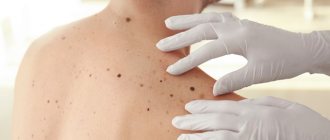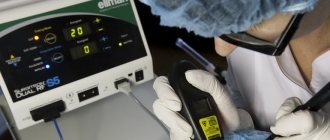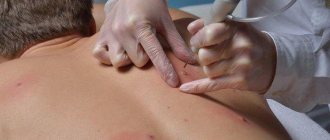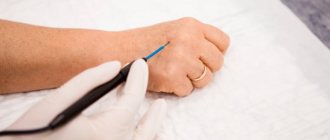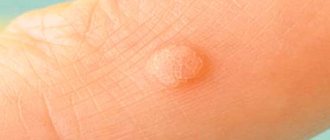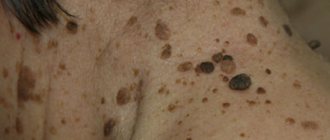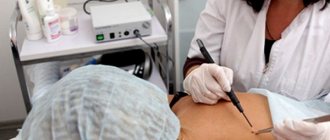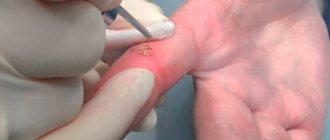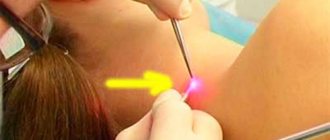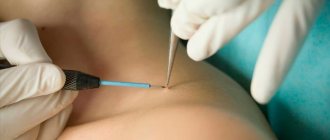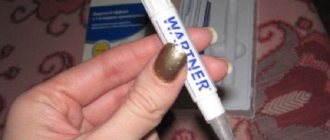Papilloma is a tumor-like formation on the skin or mucous membranes that is benign in nature. The diameter of the growths can vary from a few millimeters to 2.5-3 centimeters.
The development of wart formation is provoked by the human papillomavirus (HPV), it causes abnormal changes in cell tissues. Medicine knows a large number of variations of HPV, and accordingly, all papillomas are divided into types:
- Common warts - formations can develop if a person is infected with papillomavirus types 2 or 4.
- Flat warts - they are caused by type 10 or 3.
- Genital warts - provokes types 6 and 11.
There are particularly dangerous HPVs, for example, 33, 35 and others, they contribute to the development of cervical cancer or cause dysplasia. Such viruses are classified as a high-risk group; papillomas caused by types 6 or 11 (genital warts) belong to a low level of danger.
The papilloma virus may not manifest itself for a long time, being dormant on the mucous membranes and skin tissues. Although the course of a viral infection is often asymptomatic, it nevertheless needs to be treated, since over time the papilloma can become injured and become cancerous, and this is already dangerous for human life.
There are several ways to eliminate warty tumors (surgical cutting, laser treatment, and others); the greatest number of advantages is the removal of papillomas with a Surgitron radio wave scalpel.
Operating principle of the Surgitron device
This is a portable compact device that operates on the principle of non-contact radio wave cutting. Surgitron is equipped with a basic set of electrodes and additional devices for comfortable work. In this case, the specialist can independently select the required depth and temperature of exposure, taking into account the scale, number and prevalence of neoplasms. The operation of the device consists in the impact of highly targeted high-frequency radio waves on pathologically altered tissues: the electric current is converted into high-frequency waves, which are directed to the tissues using electrodes. Under the influence of energy, which is concentrated at the end of the electrode, destruction (evaporation) of cellular structures occurs by releasing its own energy. In this case, the electrode does not contact the tissues, the incision is made without mechanical deformation, pressure or other manual influence. The use of a radioknife does not lead to destruction of nearby tissues, does not cause coagulation necrosis, muscle spasms and irritation of nerve endings.
Which is better: surgitron or laser
Mortality from degenerated moles and papillomas is high. Melanoma, which is formed from damaged nevi, gives many metastases to internal organs.
Early identification of the problem and treatment with highly effective drugs and procedures will help save the patient’s life.
Papillomas are caused by HPV. The latter is a dangerous virus that slowly destroys epithelial cells in the human body. Malignancy of the tissue occurs. There are more than 100 types of papillomaviruses; only some strains cause serious pathologies.
Thanks to the development of medicine, the mortality rate from both diseases has been reduced. Laser and radio wave therapy treats warts, moles, and condylomas quickly and effectively. Both methods have similar properties: they remove formations painlessly, do not leave scars, and are carried out on an outpatient basis in a short period of time.
Which method of dealing with skin growths to choose is determined by the attending physician together with the patient. In addition to indications and contraindications, the patient’s financial capabilities are taken into account.
Laser surgery differs from radio wave procedure technology and mechanism of action. The laser burns out the mole and promotes thrombosis of small vessels that supply blood to the benign tumor. This action prevents the spread of metastases and minimizes blood loss. After removal, a crust remains on the pathological site, protecting the wound from infection. After a week it disappears. There are no traces left of the nevus.
Radio wave surgery destroys tumors by applying thermal energy to them. Methods indicated for treatment:
- Pigmented, vascular neoplasms.
- Fibromas and old areas of keratoses.
- The methods are used to treat cancer in situ to prevent the spread of atypical cells through the bloodstream and the formation of secondary lesions.
- Laser and radio wave surgery is used for gynecological diseases that easily turn into cancer. Among them are dysplasia and leukoplakia of the cervix.
- The procedures are performed in patients with benign diseases of the urinary canal (fibromas, papillomas).
Both methods of treating growths are considered effective. They can be used in hard-to-reach places (face, eyelids, armpits). The main difference between a laser and a radio knife is that small scars may remain.
A common disadvantage of the methods is their high cost. There is a high risk of malignancy of moles, their serious consequences put health above money. Removing moles with surgitron or a popular laser saves the patient’s life. Do not skimp on your own health, choose only high-quality treatments.
Advantages of radio wave removal of papilloma
In comparison with other destructive methods of combating pathological neoplasms, removal of warts with a radio knife has a number of undeniable advantages:
- Efficiency and high efficiency of the procedure;
- The ability to regulate the intensity and depth of radio wave exposure, which eliminates damage to surrounding healthy tissue;
- Painless intervention (if necessary, a local anesthetic is used);
- No bleeding due to the coagulating properties of radio waves;
- Possibility of histological examination of removed tumor tissues;
- Easy rehabilitation period, quick recovery;
- High aesthetic results, absence of scars;
- Minimal risk of bacterial contamination and spread of infection due to the sterilizing properties of radio waves;
- Possibility of excision of warts of any location and size;
- No postoperative complications.
The radio wave method has many advantages. This makes it one of the most effective and in demand among different categories of patients. The only disadvantage of cauterizing tumors with a radio knife is the high cost of treatment.
Potential Complications
All sorts of complications arise if the patient does not follow the rules of hygiene and does not care for the wound properly.
The most common complication is the development of infectious wound inflammation. When pathogenic microorganisms enter a wound, they may further spread through the bloodstream, which negatively affects the condition of the entire body.
In addition, if proper wound care is not taken care of, the scar may remain for several years or even a lifetime.
Contraindications to removing warts using radio waves
The method of radio wave treatment of warts has a number of contraindications. These include:
- Age up to 16 years;
- Presence of a pacemaker;
- Pregnancy, lactation period;
- Acute course of inflammatory processes;
- The presence of viral and infectious skin pathologies;
- Epilepsy and other psycho-emotional disorders;
- Glaucoma;
- Diabetes;
- High blood pressure;
- Period of menstruation.
If a wart is suspected of being malignant, the patient should consult an oncologist. In such a case, the Surgitron device is used only according to the indications of a specialist, and the removed material is sent for further histological examination. If the oncologist diagnoses the malignancy of the growth, radio wave removal of the tumor is not performed.
Indications and contraindications
There are several methods of professional wart removal, used in different situations. In particular, the radio knife is used for any type of wart, be it vulgar, filiform, plantar growths or condylomas on the genitals. Since the procedure is safe and practically painless, removal of papillomas with the Surgitron device can occur even on the mucous membranes.
Radio wave surgery is strictly prohibited for patients who have the following contraindications to the procedure:
- The patient is diagnosed with herpes.
- The person is in a feverish state.
- The patient has a built-in pacemaker.
If the above contraindications are absent, then the patient can remove various benign skin formations directly on the day of visiting the clinic after undergoing an appropriate examination. The duration of one session and their number are determined by specialists depending on the identified lesions.
How is papillomas removed using a radioknife?
The procedure for removing papilloma using the radio wave method does not require special preparation (except for a preliminary examination). Before starting the procedure, the doctor treats the affected area with an antiseptic drug and, if necessary, performs local anesthesia. To do this, the skin around the tumor is injected with an anesthetic. It is also possible to use special creams and gels with an anesthetic effect, which are used to treat the surgical field. The choice of the most suitable anesthetic drug is made by the anesthesiologist at a preliminary consultation, taking into account the individual characteristics of the patient and the clinical characteristics of the warts. After the anesthetic has begun to act (5-10 minutes), the doctor begins to cauterize the wart with Surgitron.
Before starting the treatment, the specialist sets the appropriate power parameters, selects the appropriate working electrode and begins removing the wart. Papillomas that have a pronounced stalk can be removed immediately at the root. To cauterize large, wide-based growths, the technique of layer-by-layer cauterization of pathologically altered tissues is used. During the procedure, the doctor can use various working electrodes: triangular, round loop or ball. A loop electrode is used to quickly excise a growth at the base, and a ball electrode makes it possible to remove remnants of the tumor, coagulating the vessels and leveling the wound. After completing the procedure, the doctor treats the treatment area with an antiseptic and covers it with a sterile gauze napkin.
The duration of cauterization of warts with radio waves will depend on the location, number and size of the tumors. In general, radio wave removal of growths lasts 15-20 minutes.
How is the procedure performed?
After treatment with Surgitron is prescribed, the patient is given local or infiltration anesthesia using an injection of the drug Ultracaine. It is performed in the root bed of the neoplasm. If a large area of the patient’s skin is affected, a special cream is used for anesthesia.
Then the device is turned on and configured. The doctor brings the electrode of the device to the detected tumor and eliminates it almost within a few milliseconds. The duration of the session depends on the number of papillomas, warts and other formations, as well as on their dimensions. The patient does not feel pain, the rehabilitation period lasts only a few days. A person can go home immediately after treatment with Surgitron and return to their normal lifestyle.
Patients do not need to be specially prepared for treatment with radio wave surgery. There is only one limitation for women: the described method of treating skin tumors cannot be carried out if the woman is menstruating.
During the healing period after the procedure, do not use water to wash the treated areas of the skin.
This restriction lasts 48 hours. After 2 days from the date of treatment, a person can use water procedures in full.
The rehabilitation period after radio wave removal of papilloma
After radio wave cauterization of warts, there is a recovery period, during which the patient should adhere to the following recommendations:
- Do not wet the affected area for several days;
- Treat the surgical area with prescribed medications;
- Refrain from being in direct sunlight;
- Avoid going to the sauna, bathhouse and swimming pool;
- Do not scratch and protect the resulting crust from mechanical impact;
- Visually inspect the operating area for enlargements;
- Periodically probe the area where the growth was for the presence of seals.
Two weeks after the operation, the patient must come for a second consultation with a specialist who will evaluate the condition of the postoperative wound and the results of radio wave treatment. If necessary, the doctor will provide further recommendations for caring for the affected area. Compliance with the above rules will speed up the healing process of tissue structures and prevent the development of adverse side effects.
You can carry out effective and safe removal of papillomas using the radio wave method in our specialized clinic. An individual approach to each patient and high professionalism of doctors will ensure successful treatment of tumors of any location and size.
Attention!
This article is posted for informational purposes only and under no circumstances constitutes scientific material or medical advice and should not serve as a substitute for an in-person consultation with a professional physician.
For diagnostics, diagnosis and treatment, contact qualified doctors! Number of reads: 393 Date of publication: 09/30/2018
Dermatologists - search service and appointment with dermatologists in Moscow
Wound care
Proper care ensures rapid wound healing
After removing the growth, it is necessary to carefully monitor the condition of the wound to avoid infection and other negative consequences. In order for the wound to heal quickly, the following rules must be followed:
- Monitor the cleanliness of materials used for dressing.
- In the first 3 days after the procedure, avoid getting the wound wet.
- Observe personal hygiene rules.
- A week after the procedure, it is necessary to wash the wound with warm water and soap.
- Do not use scrubs or washcloths to avoid injuring the affected area.
- Avoid direct sunlight on the wound and avoid tanning in a solarium.
- Prevent any mechanical stress on the scar.
If Surgitron was used in gynecology, the following should be considered:
- Some time after the procedure, a pulling pain syndrome may appear in the abdominal area. The pain may not subside throughout the day.
- The wound should heal under a fibrin film for at least 7 days.
- On the 5th day, the fibrin film begins to be partially rejected. At this time, minor bleeding may begin. They can last up to 20 days, after which they gradually decrease.
- The wound should be treated with an antiseptic solution.
If you follow the above recommendations, the rehabilitation period will take much less time. Proper wound care will prevent scar development.
Why remove warts
Sometimes warts can disappear on their own. This is due to the work of the immune system, which coped with the multiplication of the virus and was able to suppress its further development in the body. But in most cases, wart removal is necessary. Many methods have been developed for the treatment of papillomas. Removal of genital warts is mandatory as they can multiply. The virus can gradually infect internal organs, which in some cases leads to infertility and serious illness. Plantar warts often cause pain when wearing tight shoes or walking. In the absence of reproduction, other types of warts do not need to be removed if the growth does not cause cosmetic discomfort or pain.
Indications for radio wave surgery in dermatology
- Papillomas and warts. Find out what types of papilloma there are?
- Nevi (or moles)
- Keratomas. See what a keratoma is.
- Lipomas and atheromas
- Fibroids
- Molluscum contagiosum
- Condylomas. Read what genital warts are.
Method for removing moles, nevi, papillomas and other skin formations using radio wave method
1. Treating the skin with an antiseptic
2. Local anesthesia with an anesthetic (lidocaine, novocaine). The anesthetic is injected into the skin with a syringe or by applying a special anesthetic cream.
3. It takes 3-5 minutes for complete anesthesia of the skin.
4. The doctor takes a round loop waveguide, turns on the Surgitron device and removes the formation with a radio wave. You can remove a papilloma or mole with surgitron immediately, at the root - just like in this video.
In this case, the removed lesion can be sent for histological examination, especially if there are doubts about degeneration into cancer. But after such removal, a noticeable scar may also form.
You can also remove a mole or papilloma with surgitron using smooth fractional movements, removing the formation tissue layer by layer. Just like in this video.
>In this case, removal is carried out under visual control, layer by layer, without delving into the deep layers of the skin. Therefore, the scar in such cases is practically invisible or is completely absent.
5. The doctor takes the ball waveguide and with smooth movements removes the remaining formation on the skin, smoothing the wound. In addition, by these actions it coagulates tissue to stop bleeding.
Which device is better - laser or radio wave?
The Surgitron device has proven itself well for the removal of moles, papillomas and warts, as well as for the treatment of cervical erosion. Like the laser method, radio wave exposure is non-traumatic and has a precise impact on the desired area.
The radio knife should be chosen to eliminate small growths, and the laser method is suitable for large tumors.
The choice of device depends on the specific situation. You first need to assess the nature of the growth and collect information about possible contraindications, which is done by the doctor who will perform the procedure. Regarding the price, the Surgitron device will cost less than a laser one.
Advantages of radiofrequency surgery and the Surgitron device
To use the wart removal service in Moscow, contact our center at any convenient time.
Minimal tissue damage:
- in terms of thermal damage to tissue, Surgitron is three times safer than laser devices and electrosurgical instruments;
- when exposed to the device, a blood clot does not form in the wound;
- during removal there is practically no risk of postoperative inflammation;
- necrosis of adjacent tissues is less than 20 µm deep.
The tissue is regenerated in a short time:
- already on the third day after removal, pronounced epithelization can be noted;
- after healing, a rough scar does not form;
- pain in the wound area is insignificant.
